Solution of Right Triangles Chapter Notes | Mathematics Class 9 ICSE PDF Download
| Table of contents |

|
| Introduction |

|
| Solving When One Side and One Acute Angle Are Given |

|
| Solving When Two Sides Are Given |

|
| Applications in Geometric Figures |

|
| Real-World Applications |

|
| Solved Examples |

|
Introduction
Welcome to the fascinating world of right-angled triangles! In this chapter, we dive into solving problems related to right-angled triangles, a cornerstone of geometry that connects angles and sides in exciting ways. Whether you're finding missing sides or angles, this chapter equips you with the tools to tackle 2D problems with confidence. Using trigonometric ratios like sine, cosine, and tangent, you'll learn to unravel the mysteries of triangles with ease. Get ready to explore practical applications, from calculating heights to measuring distances, all through the lens of right-angled triangles!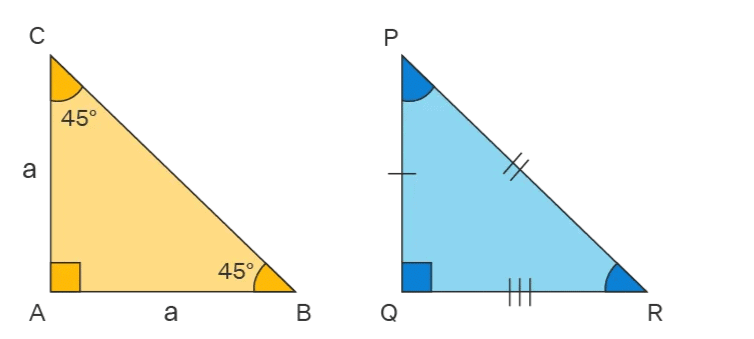
Solving a right-angled triangle means finding the unknown sides and angles.
This is done when:
- One side and one acute angle are given.
- Two sides of the triangle are given.
Trigonometric ratios (sine, cosine, tangent) are used to relate angles and sides.
Key formulas:
- sin θ = Perpendicular / Hypotenuse
- cos θ = Base / Hypotenuse
- tan θ = Perpendicular / Base
- cot θ = Base / Perpendicular
Steps to solve:
- Identify the given side(s) and angle(s).
- Choose the appropriate trigonometric ratio based on the known and unknown sides.
- Set up the equation and solve for the unknown.
- Use trigonometric tables or known values for calculations (e.g., sin 30° = 1/2, tan 45° = 1).
Solving When One Side and One Acute Angle Are Given
- Use trigonometric ratios to find unknown sides or angles.
- Identify the known side and angle, then select the ratio involving the unknown.
- Steps:
- Write the trigonometric ratio (e.g., sin, cos, tan).
- Substitute known values.
- Solve for the unknown side or angle.
- Use trigonometric values (e.g., sin 30° = 1/2, tan 45° = 1).
Example 1: In triangle ABC, right-angled at B, side BC = 20 cm and ∠A = 30°. Find the length of AB.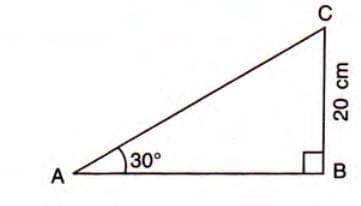
- Given: BC (base) = 20 cm, ∠A = 30°, right angle at B.
- Use cotangent: cot 30° = AB / BC.
- Since cot 30° = √3, we have AB / 20 = √3.
- Solve: AB = 20 × √3 = 20 × 1.732 = 34.64 cm.
- Answer: AB = 34.64 cm.
Example 2: In a right-angled triangle with hypotenuse 10 cm and perpendicular 5 cm, find angles x° and y°.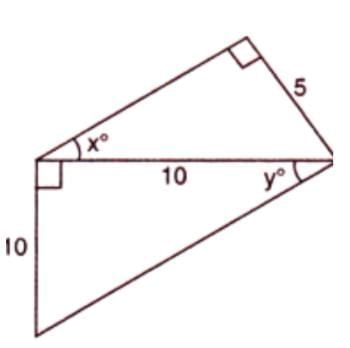
- Given: Perpendicular = 5 cm, Hypotenuse = 10 cm, Base = 10 cm.
- For angle x: sin x° = Perpendicular / Hypotenuse = 5 / 10 = 1/2.
- Since sin 30° = 1/2, x = 30°.
- For angle y: tan y° = Perpendicular / Base = 10 / 10 = 1.
- Since tan 45° = 1, y = 45°.
- Answer: x = 30°, y = 45°.
Solving When Two Sides Are Given
Use trigonometric ratios to find unknown angles.
Steps:
- Identify the two given sides (e.g., perpendicular, base, or hypotenuse).
- Choose the trigonometric ratio that relates the given sides to the unknown angle.
- Solve for the angle using known trigonometric values.
Example 3: In triangle ADC, AD = 10 cm, AC = 20 cm, find angle θ and length DC.
- Given: AD = 10 cm, AC = 20 cm, right angle at D.
- For angle θ: sin θ = AD / AC = 10 / 20 = 1/2.
- Since sin 30° = 1/2, θ = 30°.
- For DC: tan 30° = AD / DC = 10 / DC.
- Since tan 30° = 1 / √3, 1 / √3 = 10 / DC.
- Solve: DC = 10 × √3 = 10 × 1.732 = 17.32 cm.
- Answer: θ = 30°, DC = 17.32 cm.
Applications in Geometric Figures
- Right-angled triangles appear in figures like rhombuses, trapeziums, and real-world problems.
- Use properties of the figure to set up right triangles.
- Apply trigonometric ratios to find unknown sides or angles.
Example 4 (Rhombus)
In rhombus ABCD, each side is 10 cm, ∠A = 60°. Find lengths of diagonals AC and BD.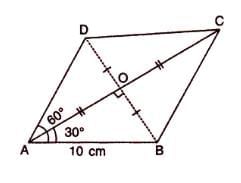
- Diagonals bisect each other at right angles, and ∠AOB = 90°, ∠OAB = 60° / 2 = 30°.
- In triangle AOB, AB = 10 cm.
- Find OB: sin 30° = OB / AB = OB / 10.
- Since sin 30° = 1/2, OB = 10 × 1/2 = 5 cm.
- Find OA: cos 30° = OA / AB = OA / 10.
- Since cos 30° = √3 / 2, OA = 10 × √3 / 2 = 5√3 = 5 × 1.732 = 8.66 cm.
- Diagonal AC = 2 × OA = 2 × 8.66 = 17.32 cm.
- Diagonal BD = 2 × OB = 2 × 5 = 10 cm.
- Answer: AC = 17.32 cm, BD = 10 cm.
Example 5 (Trapezium)
In trapezium ABCD, ∠C = 120°, DC = 28 cm, BC = 40 cm. Find AB, AD, and area.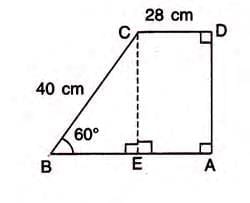
- Since CD || BA, ∠B = 180° - 120° = 60°.
- Draw CE ⊥ BA, forming right triangle CBE.
- Find CE: sin 60° = CE / 40.
- Since sin 60° = √3 / 2, CE = 40 × √3 / 2 = 20√3 cm.
- Find BE: cos 60° = BE / 40.
- Since cos 60° = 1/2, BE = 40 × 1/2 = 20 cm.
- AB = BE + EA = 20 + 28 = 48 cm (since EA = DC = 28 cm).
- AD = CE = 20√3 cm.
- Area = 1/2 × (AB + CD) × AD = 1/2 × (48 + 28) × 20√3 = 760√3 cm².
- Answer: AB = 48 cm, AD = 20√3 cm, Area = 760√3 cm².
Real-World Applications
- Right-angled triangles are used to calculate heights and distances in real-world scenarios.
- Examples include finding the height of a rocket or the length of a ladder.
- Steps:
- Draw a diagram to represent the problem as a right triangle.
- Identify given sides and angles.
- Use trigonometric ratios to find unknowns.
Example 6: A rocket rises 40 km vertically (PA), then 40 km at 60° to the vertical (AB). Find the height of the rocket at B and horizontal distance PC.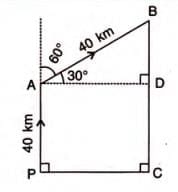
- Draw AD ⊥ BC, where ∠BAD = 90° - 60° = 30°.
- In triangle ABD, AB = 40 km.
- Find BD: sin 30° = BD / AB = BD / 40.
- Since sin 30° = 1/2, BD = 40 × 1/2 = 20 km.
- Height at B: BC = BD + DC = 20 + 40 = 60 km.
- Find AD: cos 30° = AD / AB = AD / 40.
- Since cos 60° = √3 / 2, AD = 40 × √3 / 2 = 20√3 km.
- Horizontal distance PC = AD = 20√3 = 20 × 1.732 = 34.64 km.
- Answer: Height = 60 km, PC = 34.64 km.
Solved Examples
Example 7: In triangle ABC, AB ⊥ BC, DC ⊥ BC, BD ⊥ AC, ∠D = 30°, DC = 60√3 m. Find AB.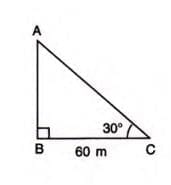
- In triangle BCD, ∠BCD = 90°, ∠D = 30°.
- Find BC: tan 30° = BC / DC = BC / 60√3.
- Since tan 30° = 1 / √3, BC / 60√3 = 1 / √3.
- Solve: BC = 60√3 / √3 = 60 m.
- In triangle BCD, ∠DBC = 180° - 90° - 30° = 60°.
- In triangle ABC, tan 30° = AB / BC = AB / 60.
- Since tan 30° = 1 / √3, AB / 60 = 1 / √3.
- Solve: AB = 60 / √3 = 20√3 m.
- Answer: AB = 20√3 m.
Example 8: In triangle ADC, AD = 10 cm, ∠ADC = 45°. Find AC.
- Given: AD = 10 cm, ∠ADC = 45°, right angle at D.
- Use tan 45°: tan 45° = AD / DC = 10 / DC.
- Since tan 45° = 1, 10 / DC = 1.
- Solve: DC = 10 cm.
- Use Pythagoras: AC² = AD² + DC² = 10² + 10² = 100 + 100 = 200.
- AC = √200 = 10√2 ≈ 14.14 cm.
- Answer: AC ≈ 14.14 cm.
|
28 videos|171 docs|28 tests
|
FAQs on Solution of Right Triangles Chapter Notes - Mathematics Class 9 ICSE
| 1. What is the significance of solving right triangles in geometry? |  |
| 2. How can one solve a right triangle when one side and one acute angle are given? |  |
| 3. What methods are used to solve a right triangle when two sides are known? |  |
| 4. What are some real-world applications of solving right triangles? |  |
| 5. Can you provide an example of a geometric figure where solving right triangles is applied? |  |



















